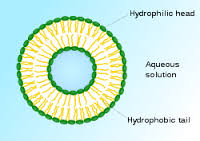LIPOSOMES: STRUCTURE AND CHARACTERISTICS
One of the main characteristics of lecithins is their high chemical reactivity: indeed lecithins hydrate and combine with other compounds such as proteins and carbohydrates. This particular feature can be significantly enhanced with the action of the liposomic form.
The liposomic form of lecithins is the set of active ingredients (phospholipids) that are structured in ‘ordered’ spatial aggregations.
The liposome structure is spherical and/or phospholipid bilamellar with the hydrophilic side on the outside.
Inside this structure there is a “combined” aqueous phase that represents and characterizes the functionalities of the liposome structure.
This structure improves and implements in a particularly significant manner the characteristic functional properties of phospholipids and significantly increases its emulsifying and emollient effects.

Specifically:
1)The acquired increased emulsifying effect of the liposome structure, as compared with a simple phospholipid, has a significant effect on the water activity AW, giving bakery products specific shelf life properties (maintaining stability, softness, friability and palatability over time).
2) The significant increase in the propensity to react with water, proteins, carbohydrates and lipids (due to the external hydrophilic surface of the liposome) significantly improves the rheological characteristics of dough mixtures as well as the development and the yield of the end product.
3) The increased absorption of water during the kneading phase makes the end product softer, lighter, tastier and more palatable. This also makes dry products less powdery and less liable to crumble.
4) The increased anti-crystallization effect due to the liposome structure (aqueous phase lipidic structure), gives specific important features to refrigerated and frozen dough mixtures by acting as a thermal regulator during an increase or a decrease in temperature.
5) The physical characteristics of a liposome enable it to coat the structure and the surfaces of food products through electrostatic interaction, protecting the cellular structure (filmogenic action), in particular for fermented yeast.

About the author